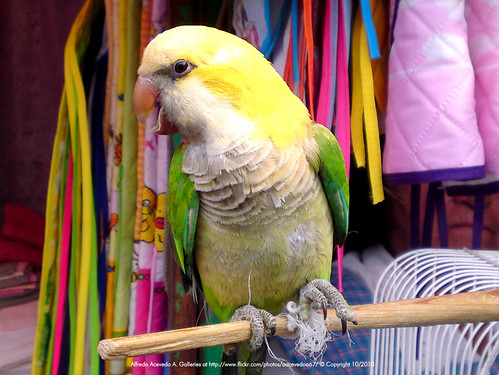Wildlife traffickers bleach parrots to increase value
 Monday, August 24, 2009 at 10:31
Monday, August 24, 2009 at 10:31  Monk parakeet, the yellow on the head is the result of bleach and paint. Image by Alfredo Acevedo Alfaro.It may not be dead, have shuffled off this mortal coil or joined the bleedin’ choir invisible, but anyone purchasing this parrot should know that it has had a paint job.
Monk parakeet, the yellow on the head is the result of bleach and paint. Image by Alfredo Acevedo Alfaro.It may not be dead, have shuffled off this mortal coil or joined the bleedin’ choir invisible, but anyone purchasing this parrot should know that it has had a paint job.
Illegal wildlife traffickers in Argentina are bleaching the plumage of common parrots and passing them off as their rarer and more valuable cousins. Wildlife groups say the burrowing parrot, a breed that inhabits most of the country’s territory, is being captured in large numbers and dyed in order to give it the appearance of a much rarer Amazon species that can fetch at least double the price on the thriving black market.
The bird, which has an olive green back, blue wings and a yellow belly with a red stain, is given a hydrogen peroxide bath to give it the appearance of a blue-and-yellow macaw, which has a much higher price tag of up to $530 (£320). They are then sold at fairs in Buenos Aires and elsewhere as part of an illegal trade in exotic wildlife worth millions of dollars annually.
Liliana De Romano, head of the Familias Protectoras de Silvestres, (Association to Protect Wildlife), said the practice was driven by an “inhuman demand” for rare parrots. In Buenos Aires, fairs operated an unbridled trade in wildlife despite animal protection laws, which she claimed were not adequately enforced. Vendors even sold the bleached parrots openly outside municipal buildings in the city, she added.
Also known as the burrowing parakeet, the bird did not always have to undergo a dye job to attract attention. Charles Darwin wrote about the species in the 1830s after encountering the birds in Patagonia, where they form the largest parrot colony in the world. But to dealers, the Amazon species “are obviously worth much more”, Ms De Romano said.
Duped buyers may find themselves trying to return dead parrots as careless bleaching can destroy their livers, causing them to die within a month. Those that survive will reveal their true colours on molting, around a year after purchase.
Claudio Bertonatti, head of the Argentine Wildlife Foundation, said the practice was common. It was “a trap, a fraud”, contributing to an illegal trade which saw poachers venturing into protected areas to capture young birds from nests, damaging their populations, he told The Times.
Once abundant across Argentina, the burrowing parrot is now in decline and has even disappeared in some areas, populations having been depleted by trappers, loss of habitat and pest control. Parrots are among the most highly sought after pets in Argentina’s exotic animal trade, the value of which is estimated to be around $50 million annually. However Mr Bertonatti said he believed the true figure to be much higher. Argentine authorities did not compile or release statistics, he said, as “that means recognising that an important illegal trade exists”.
Buyers risk not only a dead or fraudulent parrot. Mr Bertonatti said that the burrowing parrot often carried psittacosis, a potentially deadly disease that can be transmitted to humans. “A person might buy a bird with the best of intentions, for compassion, because it is in a bad situation or it is cheap, without realising that not only are they stimulating an illegal trade, but that they can contract a fatal disease.”

